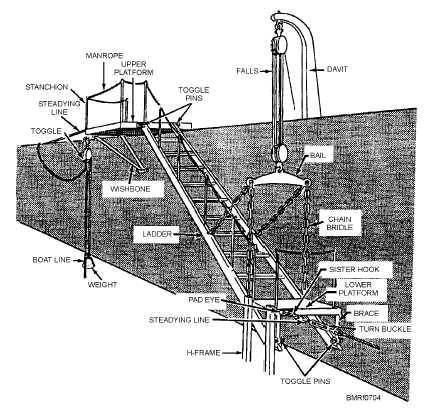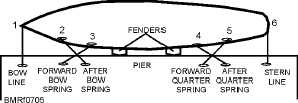line and a description of deck fittings later in this
chapter.
Rat guards are hinged conical metal shields secured
around mooring lines. They are used to prevent rats
from coming aboard ship.
The bowline and forward spring lines prevent the
ship from drifting astern. The stern line and after spring
lines prevent the ship from drifting forward. Look at
figure 7-5. Here, lines 1, 3, and 5 are called forward
lines; lines 2, 4, and 6 are called after lines. When
secured, these lines tend to breast the ship in. The
forward and after spring lines are used to prevent the
ship from drifting forward or aft.
NOTE
The various types of line and wire rope are
discussed in the “Marlinespike Seamanship”
section of this chapter.
Teamwork is essential in carrying out the
mooring operation. Lines must not be kinked or
fouled. Keep control of the lines and avoid dipping them
into the water. Remember, observe all safety
precautions!
If the ship is to remain moored for a long period,
lines are doubled up and bound together with marline
hitches, and rat guards are placed on each line. Look at
figure 7-6. To provide protection to the side of the ship
while it is alongside a pier, camels (large wooden logs or
rectangular structures) (views B and C) are often placed
between the pier and the ship. Fenders (large cylindrical
objects of rubber or fibrous material) (views A and D)
are swung over the side of the ship to give bumper
support against damage whenever a ship lies alongside
another ship or a pier.
7-4
Student Notes:
Figure 7-4.—A rigged accommodation ladder.
Figure 7-5.—Ship’s mooring lines.



